Eucalyptus globulus, commonly called the blue gum, gets its name from its distinctive and utterly unrivalled blue leaves. Their icy-blue colouring stands out against any backdrop, and while they are fast growing they are easy to control, and look wonderful when coppiced.
If you have ever had the slight inkling of growing your own blue gum, you’re in the right place. We’ve got tips, guides and step-by-steps on how to sow, plant and care for Eucalyptus globulus in any garden.
More...
Family: | Myrtaceae |
|---|---|
Genus: | Eucalyptus |
Species: | E. globulus |
Common names: | Tasmanian blue gum, Southern blue gum or blue gum |
Origin: | Australia |
Location: | Outdoor |
Type: | Tree |
Growth: | Up to 100m (rarely taller than 30m in gardens/open spaces) |
Sun requirements: | Full sun to dappled shade |
Foliage colour: | Metallic blue-green |
Flower colour: | White |
Flowering: | Year-round, flowers mostly in spring |
Edible parts: | Leaves are used to make herbal tea |
Maintenance level: | Low |
Poisonous for pets: | Whole plant is toxic to cats and dogs |
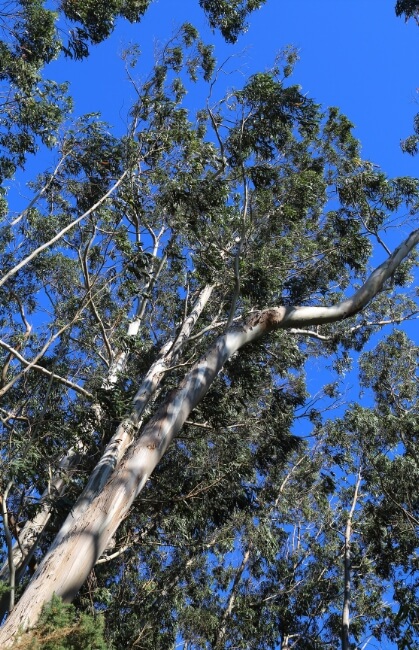
What is Eucalyptus globulus?
Southern blue gum is a species of Eucalyptus known for its heavy essential oil production and distinctive blue foliage. Not only is this native plant grown all over the world, but it makes up 65% of all hardwood plantations in Australia (around 1,100,000 acres in total).
While every example I have ever personally witnessed was 30m or less, there are records of these trees reaching 100m tall. Thankfully, in gardens, they are much easier to control and can be coppiced, pollarded, or simply pruned back every so often with ease.
Natural Habitat of Blue Gum Eucalyptus
Blue gum might be its most common name, but it is also known as the southern blue gum, thanks to all four of its subspecies being native to Southern and South-Eastern Australia.
The most recognisable subspecies (Eucalyptus globulus subsp. globulus) is native to Tasmania and the islands north of there, through to the very southern points of Victoria – Cape Otway and Wilsons Promontory.
Identifying Eucalyptus globulus
Eucalyptus globulus is easy to identify at the right time of year when its foliage is fresh, crisp and distinctly blue, but at other times of the year, you will need to pay closer attention to the leaf formation, alternating at a right angle up the stem.
The mature seed pods are glaucous, pale white or silver, with a swollen base and a rounded cap.
Check out our compilation of Eucalyptus to grow in Australia for more options to choose from.
Common uses for Southern Blue Gum
Eucalyptus globulus has a few great uses. Its most famous is for its essential oil, extracted by distillation from its foliage, but its timber is also sought after as a useful hardwood, despite it twisting during growth, making it quite hard to harvest usable straight, timbers.
Its most common use in construction is therefore fence posts. The leaves of blue gum can be used to make a herbal tea, but as with all Eucalyptus, consuming by mouth should be done with extreme caution.
How to Grow Eucalyptus globulus
Eucalyptus globulus is grown so abundantly in Australia because it is easy to grow. It’s an effective hardwood that will grow at altitude, on low-lying land, with good drainage, poor drainage, and on a variety of soil acidity, including coastal and saline conditions.
The only soil type it seems to dislike is very alkaline soil. That same ease of conditions goes for seedlings, just as for mature trees. The guide below includes step-by-steps on growing these easy-going trees.
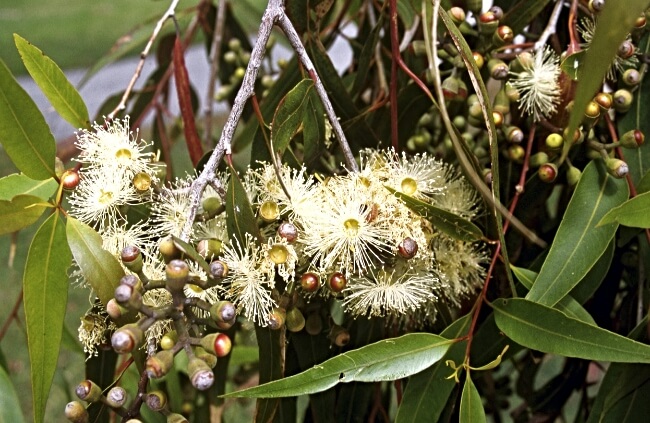
Ideal Conditions for Growing Southern Blue Gum
Saplings can be grown in the shade of their parents, and will rapidly grow to reach their mature size, but are best used as coppiced screening in gardens, where 2m can be achieved annually, and the willowy foliage makes a wonderfully characterful structure.
Soil & Drainage
Eucalyptus globulus will grow nearly anywhere, but it does have a preference.
Aim for a well-drained but fertile soil, particularly for coppiced trees, where regular regrowth puts more demands on the roots. That can be sandy loam or improved clay, but there must be some nutrients for the best possible growth.
In poor, flaky soils, with rapid drainage and no nutrient availability, you will still be able to establish Eucalyptus globulus as larger trees, but can often find fungal problems on coppice specimens.
Light & Temperature
There are no real light or temperature requirements for Eucalyptus globulus, which can grow through droughts, and cope with high rainfall and cold winters down to about -5°C.
In some parts of the country, prolonged winters can cause rapid dieback because these evergreen trees don’t just hold their leaves, they actively grow through winter, without dormancy.
Young trees should be protected from freezing, but mature trees are generally ok in climates much colder than our own.
Shelter
No shelter is needed when planting Eucalyptus globulus. It can withstand harsh rains, coastal winds, and glaring summer sun without worry, and young trees are exceptionally tough.
As always, staking young trees is worthwhile, as their roots take time to establish, and while the stems might be durable, the tree itself can topple in the first few years.
Planting Eucalyptus globulus
Provide Eucalyptus globulus with loose, fertile soil, with good drainage. Follow the guidance above for soil types, but don’t be overly worried. Whatever you plant these rugged trees in, they will nearly always grow.
Avoid heavy, wet, clay, and improve dry clay as much as you can to maintain its structure and keep water in place.
As with planting any young tree, prepare the ground by digging a hole as deep as the root ball and twice as wide. Square holes are better as they encourage roots to grow outwards rather than spiralling around.
Rub mycorrhizal fungi around the entire root ball if you have it. It’s not necessary, but it does help roots to establish faster and creates a relationship between your tree and the soil almost immediately.
Make sure the tree is positioned with its best angle facing forwards, and then backfill the hole. Heel it in and water well, then mulch with bark chippings to prevent evaporation.
How to Propagate Eucalyptus globulus
There are three ways to propagate Eucalyptus globulus, and while grafting is the most reliable, germinating the hundreds of seeds in each gum nut is by far the most practical.
Below, we’ve put together instructions for anybody who wants to have a go at propagating Eucalyptus globulus themselves, from seed, cuttings or grafting.
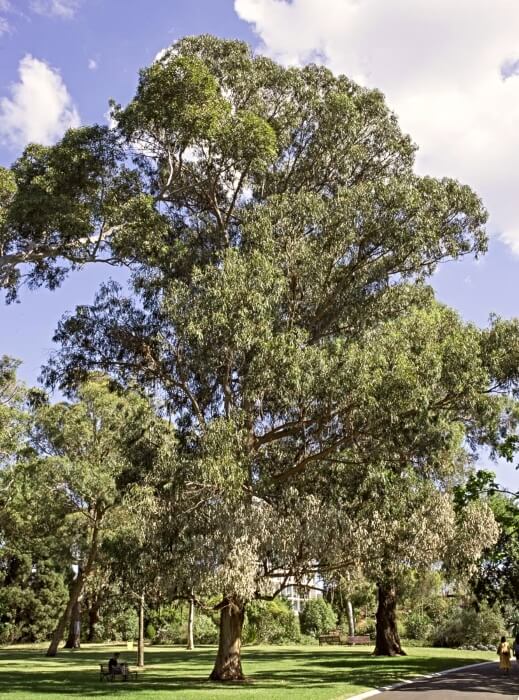
Source: IPlantz
Propagating from Seeds
Eucalyptus globulus has one or two quite specific requirements when propagating from seed. Most particular is that germination is most reliable at 13-18°C, not 18-25°C like many species.
Seeds will germinate without any cold stratification, so simply sprinkle seeds directly onto a prepared tray of seed compost in spring or summer, and leave them somewhere bright but out of direct sunlight.
As they germinate, water them just enough to keep the soil moist, and when large enough to handle, prick individual seedlings out into their own 10cm pots to grow on.
Propagating from Cuttings
Cuttings are highly unreliable, but as I always advise with eucalyptus; if you’re coppicing anyway, it's worth a go. The best time for coppicing eucalyptus is early spring, which happens to be the best time to take softwood cuttings too.
All you need is a bucket of water to place coppiced stems in as you go (this just stops them drying out, and means you don’t have to rush), a really loose potting mix, and somewhere shady to let them develop.
- After coppicing, carry your bucket of stems in water, and take just the newest growth (about 10-15cm from the tip of each stem).
- Remove the larger leaves, so that unopened buds remain.
- Trim each cutting so the cut point is just below a node.
- Poke each cutting into each corner of your pots.
- Repeat this with about ten pots (as many cuttings as you can afford the space for), to increase your chances of success.
- After about two months (having watered occasionally to keep the potting medium moist) gently tug the cutting. If it has signs of new growth, or the roots resist your tug, move it somewhere brighter to grow on. If not, don’t worry, there’s always next year.
Grafting Eucalyptus globulus
Grafting requires patience, and a rootstock to begin with. It isn’t practical for home gardeners but also isn’t as daunting as you might think. Start with the cutting material as you would for cuttings, trim the end to a sharp point, and insert it into a grafting rootstock with a notch nut out.
Seal the join either by tying tightly, or taping. While it requires you to have an expendable and healthy rooted eucalyptus, the results are more reliable.
How to Care for Eucalyptus globulus
Eucalyptus globulus requires very little general maintenance once established, but young trees do definitely show their gratitude for mulching, feeding and watering through droughts.
Never overwater, as they are drought tolerant plants, and dislike damp soil, but a weekly watering on well-drained soil will really give them a boost through summer, and help to develop more flower buds, ready for a longer autumn to spring season.
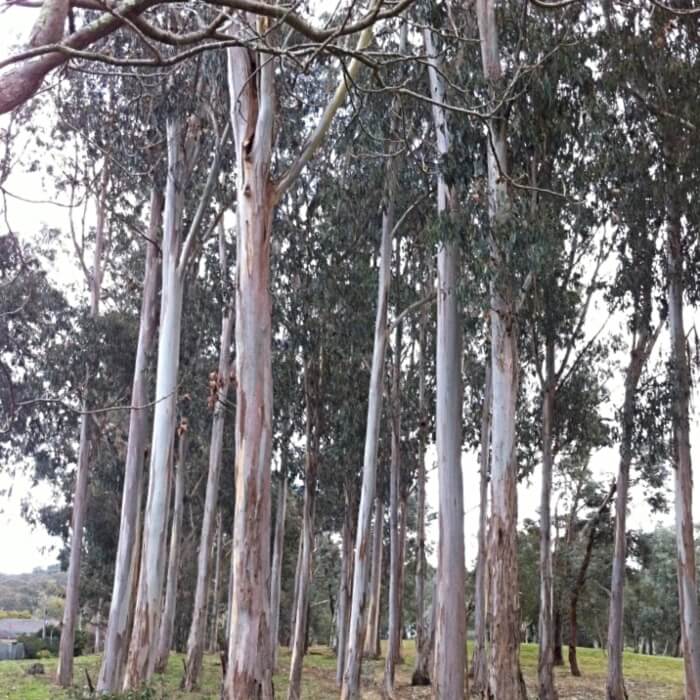
Source: Ole Lantana's Seed Store
Mulching Eucalyptus globulus
Organic mulches like well-rotted horse manure, leaf mould or simple garden compost are great for young Eucalyptus trees. Even mature trees perk up after a fertilising mulch.
Do make sure to keep your mulch well away from the stem, so it doesn’t touch the base of the tree though. Mulch about 2ft away from the tree in a generous ring. Remember, you’re feeding the roots, not the trunk.
If mulching isn’t up your street, use slow-release granular feeds while your tree is established. Any Australian native plant food will do the trick.
Pruning Eucalyptus globulus
Pruning isn’t necessary for Eucalyptus globulus, unless you are removing cankers, fungal infections or coppicing. Whenever you prune these trees, use clean tools to avoid spreading infection, regardless of the age of size of the tree.
Eucalyptus globulus Pests and Diseases
There is a startling number of pests that cause regular damage to Eucalyptus globulus, with beetles and weevils posing a particular threat. Diseases, some of which can be spread directly by these pests, are less common, but they are vulnerable to snapping and frost damage.
Pollarded and coppiced trees are especially susceptible to snapping after frosts – partly due to weakness, and partly due to infections that enter and cause those weaknesses after pruning.
The list below is by no means exhaustive, but don’t be put off growing these trees. They are easy going, resilient, and while they are not as pest-proof as other species, they are very much worth growing.
Eucalyptus Leaf Beetles
Eucalyptus leaf beetles are a huge problem on young Eucalyptus globulus, which can be very quickly defoliated depending on height and age.
If you do notice sudden deflation by feeding insects, check your plants for signs of leaf beetles, and pick them off. The small, round-backed mottled beetles are quite distinctive and simple to spot.
Even heavy infestations in mature trees will not cause significant harm. There is no need to worry about leaf beetles once your tree is properly established.
Blue Gum Psyllids
One small sap-sucking pest is the blue gum psyllid, which feeds on blue gum in particular. It can spread fungal disease between plants, but is generally not a problem worth your time or effort to deal with. The problem, as with all psyllid damage to plants, is secondary infections, rather than the damage directly caused by the insect.
Gall wasps
Gall wasps are perhaps the most problematic, partly because the wasps that emerge from the galls, having been laid inside the leaf, return to lay again. Even mature trees are often defoliated to excess as the developing wasps suck the life out of each leaf.
Another problem caused by eucalyptus gall wasps is that they are easily mistaken for rust, and dealt with incorrectly as a result. The only way to deal with gall wasps (identifiable by grey galls) is to pick the leaves off and destroy them.
There are two problems to keep an eye out for with Eucalyptus globulus; canker and oedema.
Oedema is easily mistaken for gall wasp galls, or rust, but does not do long-term harm to the tree. It is the tree trying to disperse excess water. Removing leaves prevents the tree from removing it from its roots, and can cause the death of the tree.
So if you notice signs of oedema, cross reference the symptoms online, and then leave it well alone. The tree will be fine next year provided drainage improves.
Canker is a tougher problem to deal with. The tumours growing along otherwise smooth branches simply need to be removed to stop their spread.
Eucalyptus globulus Frequently Asked Questions
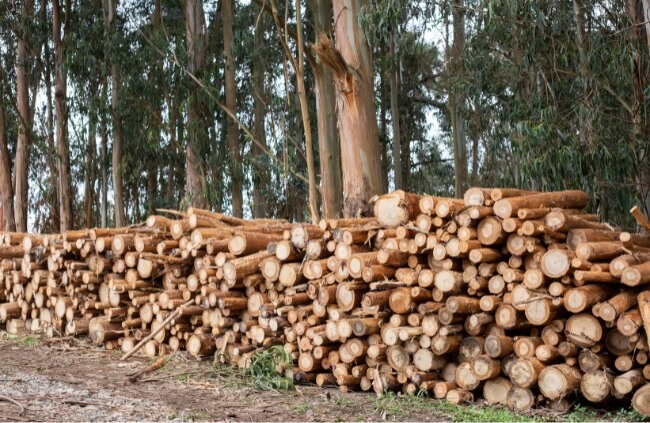
What is Eucalyptus globulus used for?
Eucalyptus globulus is one of the most common eucalyptus trees used in herbal treatments for coughs and sore throats. This is partly because of its high concentrations of essential oils, but also because it is easy to grow around the world, and uniformity works best for pharmaceuticals.
What’s the difference between Eucalyptus globulus and Eucalyptus radiata?
Eucalyptus radiata has less cineole, and therefore a softer scent, which also means it is kinder to the skin. Their physical characteristics as trees are clear, with E. radiata having significantly more pointed leaves.
Why is Eucalyptus globulus called blue gum?
Some gums are named for their flower colour, others for their bark. Eucalyptus globulus is named for its distinctly ice-blue foliage.
Which Eucalyptus is best for breathing?
Blue gum, also called southern blue gum, or Eucalyptus globulus, is the most effective decongestant used to support improved breathing and lower symptoms of respiratory distress.
What are the side effects of Eucalyptus globulus?
Eucalyptus globulus oil, if ingested, can cause vomiting, and is generally toxic, leading to potential poisoning in humans as well as pets.
Is Eucalyptus globulus safe to use?
Eucalyptus globulus is safe to use as a topical treatment, but the oils should not be consumed orally, or applied to cuts, eyes, or internally in any way.
Is Eucalyptus globulus good for skin?
Eucalyptus oil could, potentially, be regarded as good for your skin. It is cooling, soothing and anti-inflammatory, so helps to soothe skin irritation, but it is not moisturising, and will not improve your skin.
How tall does Eucalyptus globulus grow?
Eucalyptus globulus grows to a whopping 100m tall in some rare cases, but nearly all forests of this tree, including human-made plantations and parkland specimens reach an absolute maximum of 40m tall.
Does Eucalyptus globulus have invasive roots?
Eucalyptus globulus roots are not invasive. Their shallow roots will grow around objects rather than through them and are mostly in the top 1.5m of soil.
Add a Touch of Australian Wilderness to Your Outdoor with Eucalyptus globulus
Eucalyptus globulus is one of Australia’s biggest exports, but it's just as useful here as a garden plant, or as a sustainable wildlife-supporting plant for parks and public spaces.
In some very rare cases, Eucalyptus globulus has been reported as invasive around Adelaide where it has done harm to other species by outcompeting them, but these trees are widespread throughout Australia, with 538,000 hectares of dedicated plantations around the country.
Published on January 30, 2024 by Nathan Schwartz
Last Updated on March 4, 2024




